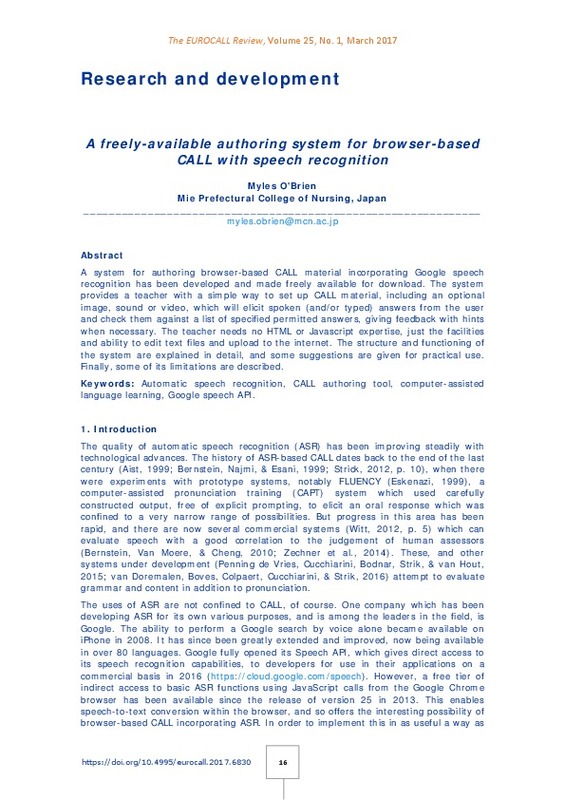Aist, G., (1999). Speech recognition in Computer-Assisted Language Learning. In Cameron, K. (Ed.), CALL: Media, design & applications (pp. 165-181). Lisse: Swets & Zeitlinger.
Bernstein, J., Najmi, A., Ehsani, F. (1999). Subarashii: Encounters in Japanese Spoken Language Education. CALICO Journal, 16(3), 361-384. Retrieved from https://calico.org/html/article_619.pdf.
Bernstein, J., Van Moere, A., & Cheng, J. (2010). Validating automated speaking tests. Language Testing, 27(3), 355-377. doi:10.1177/0265532210364404
[+]
Aist, G., (1999). Speech recognition in Computer-Assisted Language Learning. In Cameron, K. (Ed.), CALL: Media, design & applications (pp. 165-181). Lisse: Swets & Zeitlinger.
Bernstein, J., Najmi, A., Ehsani, F. (1999). Subarashii: Encounters in Japanese Spoken Language Education. CALICO Journal, 16(3), 361-384. Retrieved from https://calico.org/html/article_619.pdf.
Bernstein, J., Van Moere, A., & Cheng, J. (2010). Validating automated speaking tests. Language Testing, 27(3), 355-377. doi:10.1177/0265532210364404
Ellis, R. (2008). A typology of written corrective feedback types. ELT Journal, 63(2), 97-107. doi:10.1093/elt/ccn023
Eskenazi, M. (1999). Using automatic speech processing for foreign language pronunciation tutoring: Some issues and a prototype. Language Learning & Technology, 2(2), 62-76.
Golonka, E. M., Bowles, A. R., Frank, V. M., Richardson, D. L., & Freynik, S. (2012). Technologies for foreign language learning: a review of technology types and their effectiveness. Computer Assisted Language Learning, 27(1), 70-105. doi:10.1080/09588221.2012.700315
Guénette, D. (2007). Is feedback pedagogically correct? Journal of Second Language Writing, 16(1), 40-53. doi:10.1016/j.jslw.2007.01.001
Levy, M. & Stockwell, G. (2006). CALL dimensions: Options and issues in computer-assisted language learning. Mahwah, NJ: Lawrence Erlbaum Associates.
Munro, M. J. (2011). Intelligibility: Buzzword or buzzworthy? In. J. Levis & K. LeVelle (Eds.). Proceedings of the 2nd Pronunciation in Second Language Learning and Teaching Conference, Sept. 2010. (pp.7-16),Ames,IA: Iowa State University. Retrieved from http://jlevis.public.iastate.edu/2010%20Proceedings%2010-25-11%20-%20B.pdf
De Vries, B. P., Cucchiarini, C., Bodnar, S., Strik, H., & van Hout, R. (2014). Spoken grammar practice and feedback in an ASR-based CALL system. Computer Assisted Language Learning, 28(6), 550-576. doi:10.1080/09588221.2014.889713
Strick, H. (2012). ASR-based systems for language learning and therapy. In O. Engwall (Ed.), Proceedings of the International Symposium on Automatic Detection of Errors in Pronunciation Training (pp. 9-20). Retrieved from http://www.speech.kth.se/isadept/ISADEPT-proceedings.pdf.
Van Doremalen, J., Boves, L., Colpaert, J., Cucchiarini, C., & Strik, H. (2016). Evaluating automatic speech recognition-based language learning systems: a case study. Computer Assisted Language Learning, 29(4), 833-851. doi:10.1080/09588221.2016.1167090
Witt, S.M. (2012). Automatic Error Detection in Pronunciation Training: Where we are and where we need to go. In O. Engwall (Ed.), Proceedings of the International Symposium on Automatic Detection of Errors in Pronunciation Training (pp. 1-8). Retrieved from http://www.speech.kth.se/isadept/ISADEPT-proceedings.pdf.
[-]








